Have you succeeded on Shopify and want to expand your reach to Walmart? That’s a smart move to diversify your online business. However, manually transferring your product listings is not only time-consuming but also error-prone.
Fear not, as this guide will walk you show you how to sell on Walmart with Shopify store seamlessly. Discover this guide to learn effective tools and tips to streamline your operations and maximize your sales potential on both platforms.
We’ll go through:
- How to sell on Walmart with Shopify in 4 steps?
- Why sell on Walmart with Shopify?
- Tips for selling on Walmart for Shopify sellers
Sell on Walmart with Shopify Made Easy with LitCommerce
While Shopify helps you grow your brand and display all products in your own creative way. Walmart can be a good start if you want to reach more potential buyers globally.
How to Sell on Walmart with Shopify in 4 Steps?
If you need help with Walmart Shopify integration, this guide will show you 4 easy steps to do so.
See more: How to Connect Shopify to Amazon in 5 Steps with LitCommerce – 2024 Guide and New Features.
Step 1: Set up your Shopify store
Before you can sell on Walmart with Shopify, you need to have a Shopify store up and running. If you haven’t set this up yet, follow these steps:
#1: Visit Shopify’s website and click the Start free trial button.

#2: Next, you will be presented with a series of questions, each with the premade answer choices about “Where would you like to sell?”, “What do you plan to sell first?”.
You can skip them entirely or select the answers that best match your preferences and business needs.
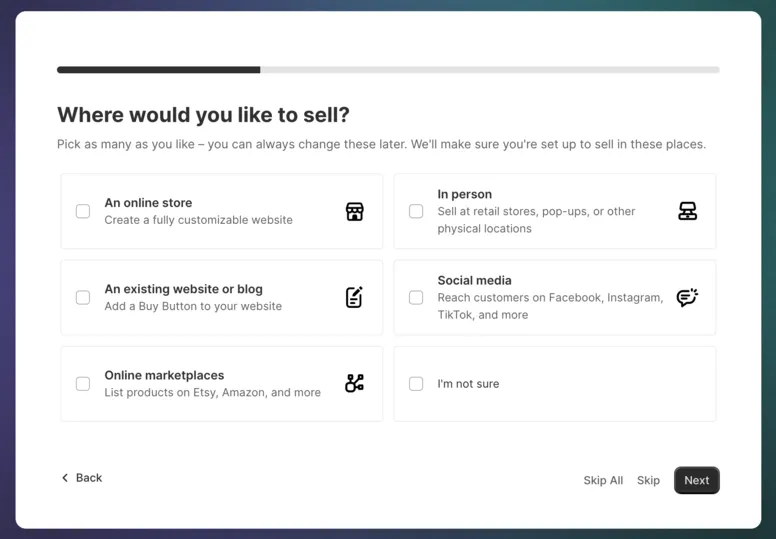
#3: Choose your signup option, then you’ll be redirected to the admin panel. Now, you’re ready to set up your Shopify store and store name and begin your four-day free trial. After the trial, you can choose from four plans to continue selling with Shopify.
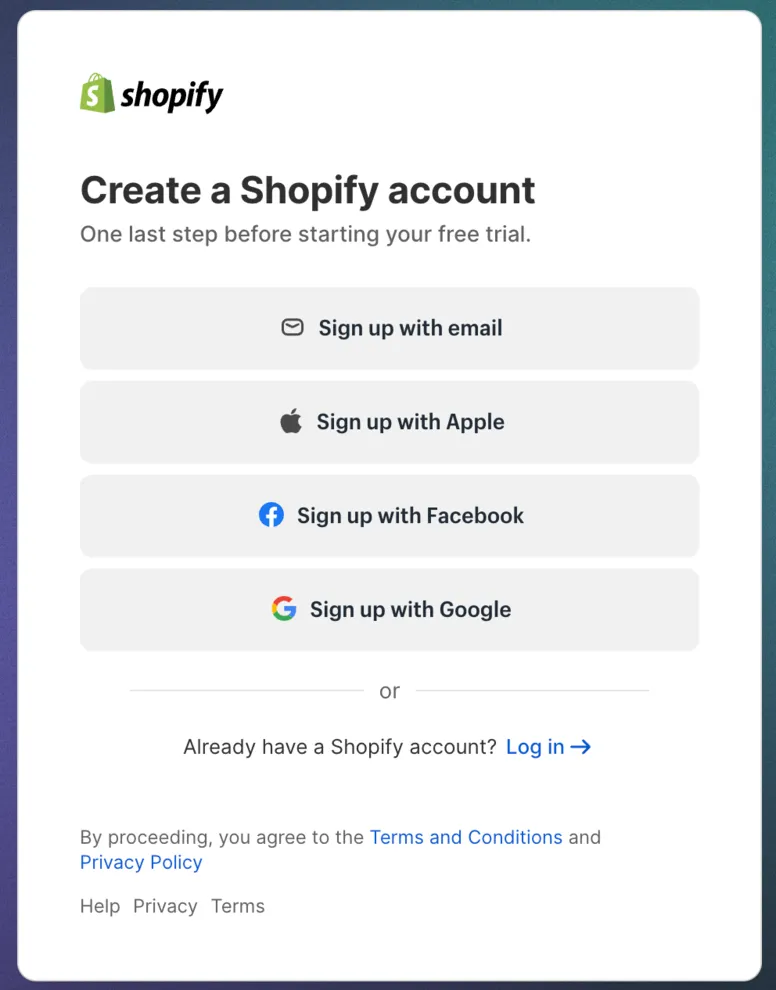
#4: Select where your business is located.

#5: Customize your store: Finally, to complete your store, add your first products & product-related content, domain, and store name, and set up shipping.
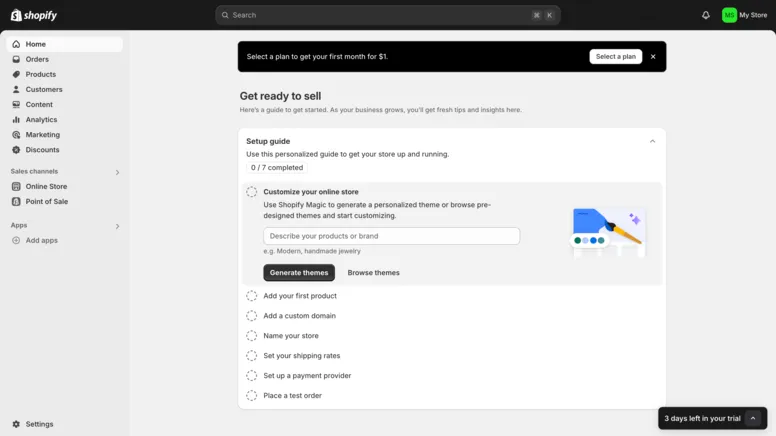
Step 2: Set up your Walmart store
Setting up a Walmart store may need some effort – and don’t worry, we’ve laid everything out to help simplify the process.
#1. Get prepared.
For a smooth registration process, make sure you have everything you need, including:
- Business Tax ID(s) (SSN not accepted) or Business License Number.
- Supporting documents that verify your Business Name and Address.
- History of marketplace or eCommerce success.
- Products that have GTIN/UPC GS1 Company Prefix Numbers.
- Catalog that complies with Walmart’s Prohibited Products Policy.
- Fulfillment through Walmart Fulfillment Services (WFS) or another B2C US warehouse with returns capability.
#2: Sign up.
Head over to the Walmart Marketplace signup page. Complete the necessary information, carefully review the terms and conditions, and proceed to create your Walmart Marketplace account.
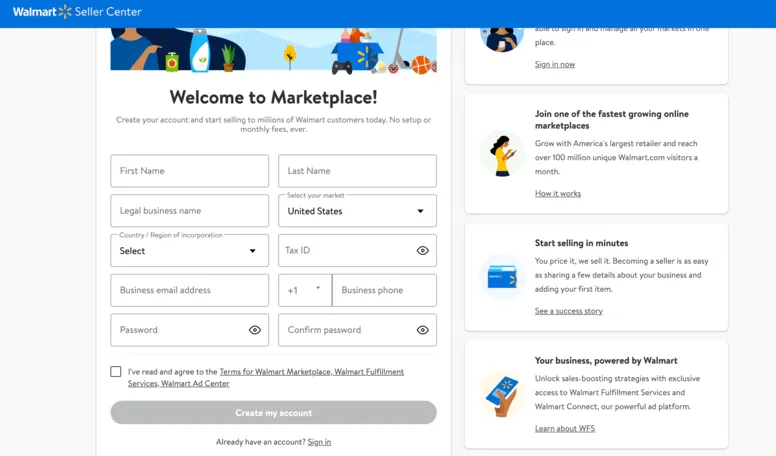
#3. Business verification.
Verify your business by submitting your details and completing the Seller Profile. Ensure your tax information matches IRS records so we can verify your business quickly and help you sell faster.
#4. Set up payments and shipping.
Next, choose where to send your payments and configure your shipping methods and costs. Select your preferred returns method and carriers for your budget.

After you’ve filled out, reviewed, and finalized the forms, you’ll submit your request and wait one week for Walmart to approve your seller registration.
Step 3: Install Shopify app for connecting 2 channels
You can sell on Walmart with Shopify using the built-in app in Shopify or LitCommerce (a famous tool for multichannel selling). We will give more details about each option below.
Option 1: Built-in Shopify marketplace connector app
The Shopify Marketplace Connect app lets you easily link your products with your Walmart dashboard and directly oversee your listings, orders, and stock from your Shopify account. If you make any changes to products and orders in your Shopify store, it’ll seamlessly sync with Walmart listings. To use the Shopify marketplace connector to connect Walmart to Shopify, follow these steps:
#1. Visit Shopify App Store and search for Shopify marketplace connector.
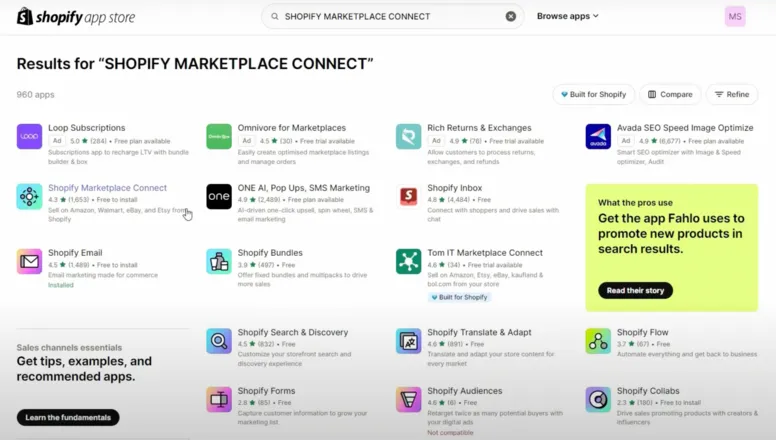
#2. Click the Install button for Shopify Marketplace Connect in the Shopify app store.
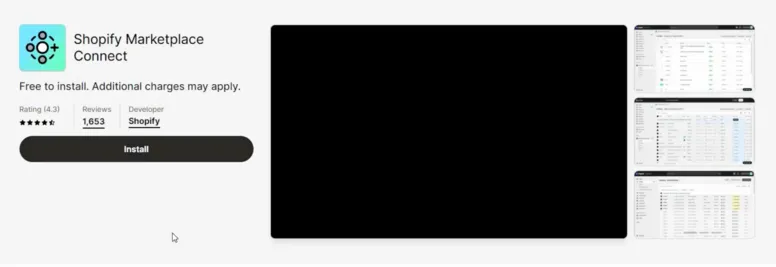
#3. Configure before connecting:
- Ensure your Walmart seller’s account is verified.
- Set up and display shipping rates.
- Make your store policies visible according to the marketplace’s requirements.
- Establish a method to receive payments.
#4. Connect:
- Navigate to Shopify admin > Settings > Apps and sales channels > Marketplace Connect > Open app.
- Select Connect marketplaces, choose Walmart and follow the prompts for Walmart.
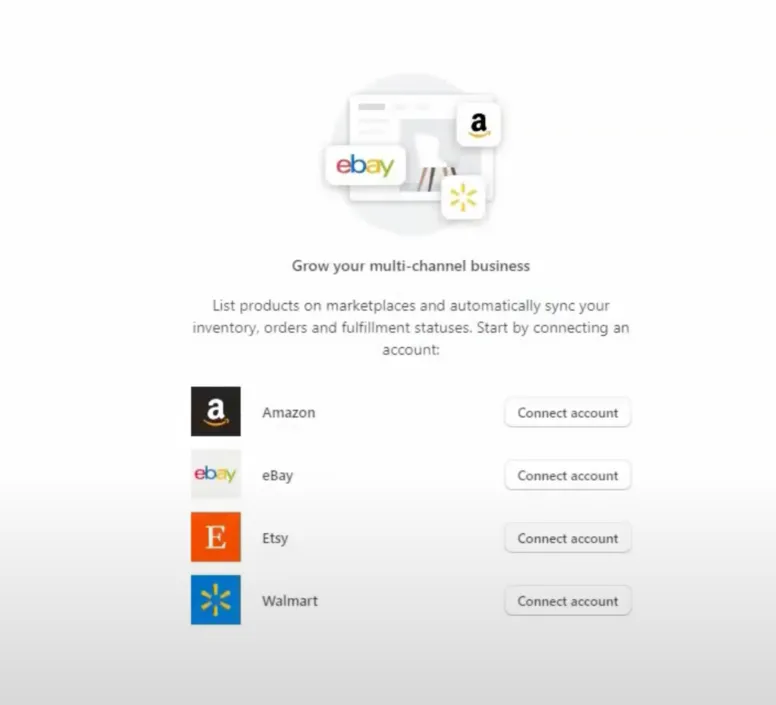
- Sync products, inventory, and orders
You can then change product details in Shopify, which will automatically update on the connected marketplace.
Option 2: LitCommerce – powerful multichannel selling tool
LitCommerce is another solution if you want to sell on Walmart with Shopify. LitCommerce offers all the same features as Shopify’s marketplace connector but at a lower cost and with the ability to connect to more sales channels. This means you can save money and expand your business reach. So, how can you use the LitCommerce tool for Walmart Shopify integration? Check it out below:
#1. Connect the LitCommerce tool with your Shopify store
Visit app.litcommerce.com and swiftly create an account by logging in through Facebook or Google. You don’t need to select a tier yet; start with the 7-day free trial with full access to premium features to explore the app indefinitely.
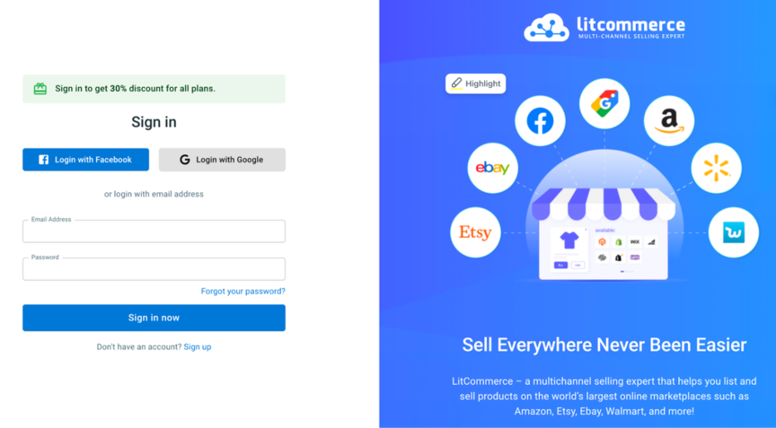
Also, you can install the LitCommerce app on Shopify by heading to the Shopify App Store and search the name. Once you are connected to Shopify, LitCommerce will direct you to link your Walmart account in just a few clicks.
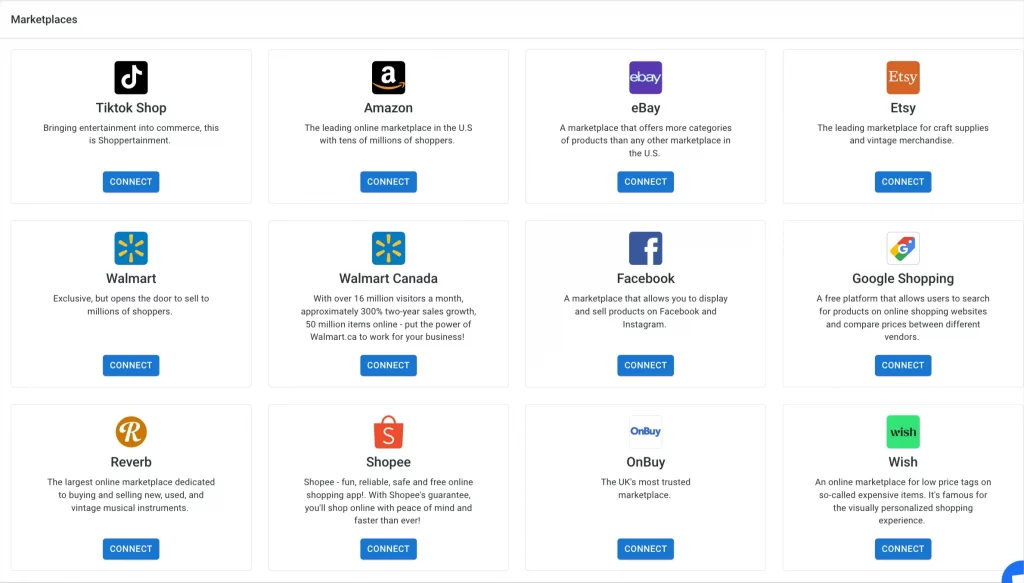
You can sell with Shopify via various channels with ease by checking these guides:
How to Integrate Shopify with eBay in 4 Steps with LitCommerce
#2. List products from Shopify to Walmart
- To begin, once your Shopify is linked, LitCommerce will automatically bring in all your existing products from Shopify to the main LitCommerce dashboard.
- Head to Management > All Products. You’ll find all your Shopify items listed there. Should there be any new additions on Shopify, just click the “Update from Shopify” button.
- Select the checkbox next to the product you wish to sell on Walmart.
- Next, opt for Walmart from the dropdown menu labeled List Products on the Channel.
- You’ll then receive a confirmation message stating that Draft listings have been successfully generated. This indicates that all products are saved as draft listings for future editing.
- After editing the listing if needed, select Save and publish.
Step 4: Manage both stores on Shopify
The final phase of Shopify Walmart integration involves efficiently managing the order process. This includes handling essential data like listing, inventory, and orders. Fortunately, by using the Marketplace Connector app, you can easily manage the data automatically:
- Managing listings
You can easily manage your listing in both Shopify and Walmart since the Marketplace Connector app automatically synchronizes between the two platforms. This includes essential details such as product titles, descriptions, images, prices, and variations. Any changes made on either platform are instantly reflected on the other, ensuring consistency and accuracy across all sales channels.
- Managing inventory
As soon as a product is sold on Walmart, the inventory is automatically updated on Shopify. This prevents overselling and ensures accurate stock availability information for customers.
- Managing orders
Once a customer places an order on Walmart, Marketplace Connect adds it to the Orders section of your Shopify admin. It’ll appear as if it was directly purchased from your online store.
Don’t Stick to One Channel— Let’s Expand and Thrive
LitCommerce offers an affordable multichannel solution to connect, list, import, and sync between Shopify and Walmart quickly. Start with a 7-day free trial and then choose the pricing that suits your needs.
Why Sell on Walmart with Shopify?
Selling on Walmart with Shopify can be a great way to grow your business. You can use the strengths of both platforms to reach more customers and sell more products.
- Leverage the benefits of both sales channels
Shopify is known for its user-friendly platform and design tools. At the same time, Walmart is a huge marketplace with millions of shoppers. By using both, you get the best of both worlds. You can use Shopify to create a beautiful online store and then easily list your products on Walmart to reach a wider audience.
- Sell on both platforms with ease
You don’t need to manage two separate systems. Shopify makes it easy to list your products on Walmart. You can sync your inventory, orders, and shipping information between the two platforms. This saves you time and helps you avoid mistakes.
- Reach a wider audience
Walmart has a massive customer base. By selling on Walmart, you can reach new customers who might not have found your Shopify store. This can help you increase your sales and grow your business.
- Promote your sustainable growth
Selling on both Shopify and Walmart can help you build a strong foundation for your business. You can use Shopify to develop a loyal customer base and then expand your reach with Walmart. This can help you achieve sustainable growth over time.
Tips for Selling on Walmart for Shopify Sellers
You can sell on Walmart with Shopify with ease if you know these tips. Keep reading to check it out!
1. Provide excellent customer service
Shopify merchants should deliver fast, friendly, and reliable customer service. To differentiate their stores from competitors, merchants should foster repeat business and positive customer experiences.
2. Set competitive prices
Shopify merchants should conduct market research on their products to establish competitive prices. They should define promotional pricing strategies and offer incentives like free shipping to attract customers while maintaining a healthy profit margin.
To increase the likelihood of customers choosing their products over those of competitors, merchants should win the Buy Box by offering competitive prices and maintaining a high seller rating. The Walmart Buy Box is a coveted position that determines the seller whose listing appears when multiple sellers offer the same product. Although all listings are displayed on a single page, only one seller can secure the Walmart Buy Box.
3. Leverage Walmart Fulfillment Services (WFS)
Walmart Fulfillment Services (WFS) is your ticket to two-day shipping and low-cost fulfillment on Walmart Marketplace. When you leverage WFS, you instantly gain access to one of the world’s largest supply chains.
WFS provides full-service fulfillment for third-party sellers, reducing the strain of fulfilling orders in-house so you can scale faster.
4. Prioritize inventory management
Efficient inventory management is a critical component of business management. By carefully monitoring and controlling stock levels, merchants can prevent issues like overselling or stockouts that can harm operations. Shopify provides integrated tools for inventory management, or merchants can utilize external inventory management systems.
5. Utilize SEO
Merchants should optimize product titles, descriptions, and images for search engines. Incorporating relevant keywords can enhance the visibility of published products on Walmart and drive traffic to product listings.
Shopify Walmart Integrations: FAQs
Absolutely. Shopify offers a built-in app called Marketplace Connect to help sellers expand their reach to Walmart and other online marketplaces. On the other hand, you can also use the LitCommerce tool, which provides a similar solution but often offers more features, flexibility, and potentially lower costs for managing multiple sales channels. Walmart’s partnership with Shopify was primarily driven by the need to strengthen its online presence and compete more effectively with Amazon. Shopify has a vast network of merchants. By partnering with Shopify, Walmart could expand its network and increase the product variety offered on its marketplace. Integrating Shopify with Walmart offers several significant advantages for online retailers because you can:
Let’s Wait No More and Start Integrating Now!
Use this guide to enhance your reach and sell on Walmart with Shopify. This way will help streamline operations and drive the growth of your business. You can easily use the built-in Shopify marketplace connector app for the integration or employ LitCommerce if you wish to sell on more marketplaces or eCommerce platforms with your existing Shopify shop.
For more interesting information, you can check out our LitCommerce blog or contact us anytime.




